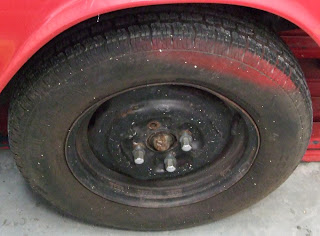This isn't my first rodeo. My first project that I worked on was a 1967 Mustang Coupe, with an inline 6.
The tale as I remember is as follows. The facts are likely obscured in time and my bad memory, This may get corrected as the facts get sorted out.
My Father was faced with getting a car for my brother. He had been eyeing this mustang parked under a pine tree for many years, belonging to someone he worked with. PO had bought it for his daughter and kept it after she had moved on to other vehicles. The transmission was removed from the car, sitting on the back seat if my memory serves me correctly.

He made a deal with the PO to buy the car IF it would run after re-installing the transmission. It did and he bought it.

We stripped the car to bare metal, bondo-ed the crap out of it, not too many dents, but they were everywhere. The worst was the driverside fender, with the hump caved in and no way to pop it back out easily. The only pannel not needing repair was the passenger side fender.
Next comes a layer of primer, and following that paint. The painter was someone my dad worked with and sprayed the car as a favor for him. It's good to have friends.

Two of these pictures are from showing the car, restored, to it's PO. It's good to let them see that their efforts to keep it alive are not wasted. My brother drove the car until his car lust turned to a Pontiac Fiero.
The mustang was parked at my Grandmothers house, until the time came for me to have it as my first car. In retrospective, my parents funded the purchase of the car, and my brother paid them back. They funded my brothers Fiero (buying back the mustang in the process), and sat on the car after I expressed interest in it. My grandmother housed the car until I was ready to re-paint and restore again (easier the second go round). I don't think I ever thanked them for their efforts fully and really miss the oppertunity to thank my grandmother, as she has passed, for the simple gestures of facilitating my first car.
MY Mustang...
I learned to drive in it, and used it to drive myself to high school and work. I had some very good times in it and my worst nightmare.
One night after work, my friend wanted to go out for a drink, I wasn't in the drinking mood but I agreed to go. He was out of work with a cast on his right hand. He wasn't supposed to be driving, but you know... I followed in my car, being extra careful as it had just started drizzling. I had just replaced the front breaks and they were very responsive. He broke very late for a turn and turned awkwardley into the driveway as he almost missed it. I was a good ways behind but I locked up the breaks, looked to the right and couldn't ditch it as a van was in a driveway waiting to pull into traffic. I couldn't swing left, traffic was whizzing by in the left lane. R.E.M. was playing on the tapedeck, "It's the end of the world as we know it (and I feel fine)" Strangely appropriate. If I had let up on the breaks, I would have bumped bumper to bumper and a few scratched would be all to this tale but... I slid into the back end of my friend's pickup trunk, his bumper sliding just on top of my bumper, lowered by the breaking...

I learned alot that night. I learned alot about family, how much my brother cared for me, how strong my father was in the face of adversity, and how much family stood together in a crisis.
That was the end of my mustang. Realistically, it wasn't relyable enough for me for work and school and the repair work was beyond out means at the time. She was sold off as a parts car. The buyer specifically said it was to be parted out. OUCH!
Never fear, many many years later, I saw a car parked in the University parking lot that looked sorta nice. On closer examination, it was my mustang, rebuilt and on the road. I never met the current owner, but all the special additions to the car remained intact as well as the paint color. I hope the car is providing someone else with pleasure to this day. It got me through an important part in my life and for that I will always have a bit of my heart into that car.








































